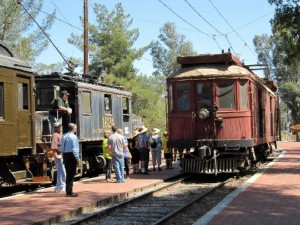I received an email from Robert L. Davis, a longtime Angeleno who remembers the original Pacific Electric streetcar lines from his boyhood. He grew up near the old Monrovia line, which shared the Pasadena lines as far as South Pasadena and San Marino. The old line is defunct and now filling up with housing units. Here is an edited, abridged version of his recollections:
I grew up on Fifth Ave. in Monrovia, on the north side of the Pacific Electric (PE) right-of-way. From the time I was old enough to notice, to the sad days in 1952 when the track and trolley wire were ripped out, PE was part of my life. Typical weekday service was a car every half-hour to Monrovia, with every other car continuing to Glendora. Rush hours would see two and three car trains running on ten or fifteen minute headways. Add to this a daily freight train, a daily “box motor”, and assorted work cars, and there was a lot to watch.

Two PE “home-brew” cars (built in Torrance in 1925) and the big brown tower car (built in Los Angeles in 1915) with the author running it.
When I was in fourth grade at Monroe School, the westbound freight rumbled past around 1:30 PM on its way to Los Angeles. The City of Monrovia had installed a stop sign at Olive and Mayflower, where the track left street-running and resumed private right-of-way, and I’d hear the hiss of air brakes and the clanking of the train coming to a halt. The head brakeman probably got off to flag the crossing, and the engineer (by this time the electrics had given way to diesel power) would turn on the air-operated bell and start up with more rattling and clanking as the slack pulled out. Whatever was under discussion in class was totally lost to me.
Diesel locomotives started appearing on freights in the late 1940’s. As late as the mid-1970’s, diesels used on former PE lines in Santa Monica, Beverly Hills and West Hollywood had interurban-style whistles, and engineers (some of whom were ex-PE motormen) were forbidden to use regular air horns on the “Westside”. Back in 1968 I decided to check out the Hollywood Midnight Switcher. I found the crew switching on Santa Monica Blvd. After the switching was completed, I followed the unit all the way through Beverly Hills, soaking up the mellow toot of the air whistle and the rumble of wheels on well-worn rails.
Pacific Electric’s track through Monrovia was in poor condition and was mostly original 1903 steel. Any plans for retaining rail service past 1951 would have had to include completely rebuilding the track. Construction of the Santa Ana/San Bernardino Freeway past Union Station canceled any hope of that happening by taking PE’s exit from downtown toward the San Gabriel Valley. The idea of building a grade-separated rapid transit line was discussed, but no business or political entity would ante-up the money.
Today the Red Car era lives on, especially during special events, such as “Pacific Electric Weekend,” which has been observed during June in 2006 and 2007 and may become an annual event. Every ex-PE unit that runs comes out for photo ops and (if feasible) passenger service. In addition, visitors to the west side of the Los Angeles Harbor at San Pedro can ride replica Red Cars built under the sponsorship of the L.A. Harbor Department. The cars, which represent PE suburban cars from 1915 or thereabouts, run Friday through Sunday from the Cruise Ship Terminal to 22nd St.
Thirty years ago, if someone had said, “The Long Beach Line, parts of the San Bernardino Line, and a section of the San Fernando Valley Line will reappear,” such predictions would be greeted with “dream on” and “what have you been smoking lately?” Traction fan gatherings would be devoted to slides and movies of long-vanished trolley lines and plans for trips to San Francisco to ride the west coast’s last outpost of streetcar service. Today, between the four Metro Rail electric lines and the seven Metrolink services, it would take a long day to cover even a good percentage of the original Pacific Electric lines.
3 thoughts on “Remembering the Old Los Angeles Trolley Lines”
-
Pingback: Should Pasadena’s “Gold Line” Have Been Commuter Rail Instead? | Ethan Elkind
-
Pingback: The Pasadena Gold Line “NOBLAG” NIMBYS | Ethan Elkind
-
Pingback: Dispatch From The San Gabriel Valley Gold Line Rail Construction | Ethan Elkind
Leave a Reply
You must be logged in to post a comment.


